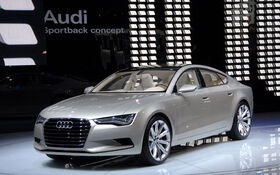Debut in Detroit: Audi Sportback Concept
Debut in Detroit: Audi is unveiling the Sportback concept show car at the 2009 North American International Automobile Show. With systematic refinements to the brand’s characteristic design elements, the five-door model offers a glimpse at the Audi's future design vocabulary. With its pronounced coupé-like silhouette and large rear hatch, the 4.95 m long (16.24 ft), 1.93 m wide (6.33 ft) and only 1.40 m high (4.59 ft) vehicle is boldly progressive for the luxury class.
The technology of the Audi Sportback concept is markedly futuristic. Power is provided by the world’s cleanest diesel technology: the 3.0-liter V6 TDI clean diesel almost completely eliminates nitrogen oxides. This engine already meets the emissions limits of all 50 U.S. states and the EU6 standard scheduled to take effect in 2014. And numerous measures to ensure top efficiency mean that the Audi Sportback concept is expected to achieve impressive fuel consumption figures of 5.9 liters of diesel per 100 kilometers (39.87 US mpg).
Design
The design of the Audi Sportback concept is characterized by an almost monolithic clarity and a vast reduction of the number of lines. The roof, shoulder and sill lines appear to have been drawn with a single stroke. The window strip of the coupé with its four frameless doors was kept pronouncedly flat. Viewed from the side, the softly contoured wheel wells over the 10-spoke, 21-inch wheels reinforce the impression of the precisely defined surfaces of the body.
One feature familiar from the two-door Audi A5 coupé is even more boldly accentuated here: The markedly horizontal shoulder area emphasizes the orientation of the vehicle body to the road. This effect is further reinforced at the front and rear by the broad, flat LED light units. The shape of the almost fragile-looking side mirrors is inspired by the upturned tips – the “winglets” – of modern jet wings.
The show car also offers a new interpretation of the single-frame grille. The decision not to use vertical struts and the low overall height emphasize the sporty basic proportions of the vehicle front. Also particularly striking is the modified outer contour of the single-frame grille as also featured on the A1 Sportback show car. The flattened top edges lower the visual center of gravity and provide a striking look for the front end.
Drivetrain
The developers at Audi chose the world’s cleanest diesel technology as the unit best befitting the Audi Sportback concept show car. The six-cylinder 3.0 TDI clean diesel is equipped with a system for the effective reduction of nitrogen oxides. The diesel engine development engineers at Audi have combined an entire package of innovative measures for this latest TDI generation: The piezo common rail system with an injection pressure of 2,000 bar, highly efficient exhaust gas recirculation and optimized turbocharging result in significantly reduced raw engine emissions. One of the highlights are the combustion chamber sensors that enable even more precise regulation of the combustion processes in the engine – this is the first time that such sensors have been installed on any engine in the world, marking yet another Audi innovation.
The status of the new-generation TDI as the definitive clean-running, high-tech diesel is sealed by the downstream exhaust emission control system, which reduces emissions by up to 90 percent. The system uses AdBlue, a biologically degradable, waterborne additive that is injected in small amounts upstream of the DeNOx catalytic converter. In addition to the catalytic converter, the exhaust emission control system comprises the metering module, the AdBlue tank and heated lines, as well as an extensive system of sensors. The additional oxidizing catalytic converter and the highly efficient, regulated diesel particulate filter round off the comprehensive emission control system.
The Audi Sportback concept’s average fuel economy according to the European ECE standard is only 5.9 liters of diesel per 100 kilometers (39.87 US mpg), and its CO2 emissions no more than 156 g/km (251.06 g/mile). These sensationally low figures for a large model have been achieved by extensive efficiency-optimizing measures.












